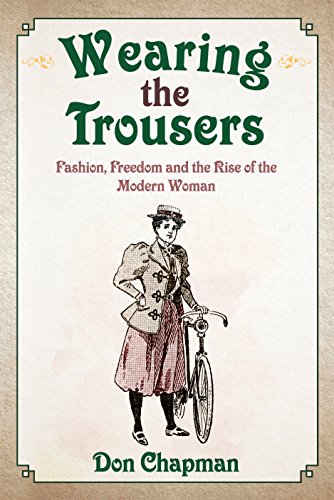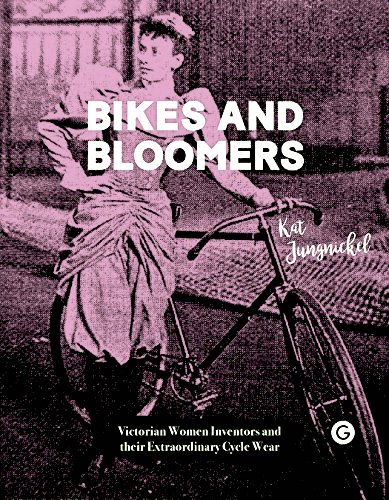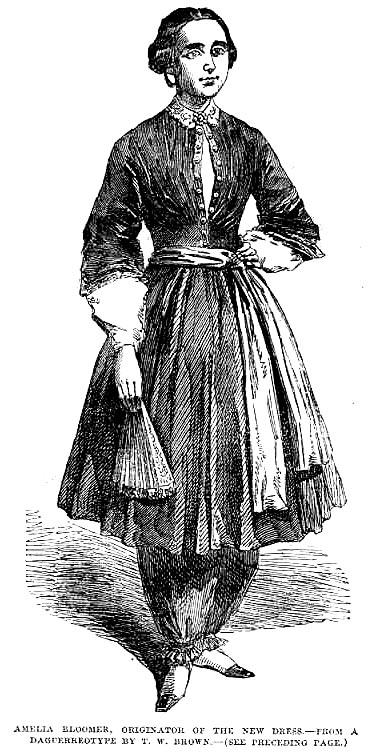The second part of this review, dealing with Kat Jungnickel's book, originally appeared under the title of "On their Bikes" in the Times Literary Supplement (8 June 2018: 13). Page references and illustrations have been added here. [Click on the images for larger pictures and more information where available.]
 o one could possibly have imagined that women's call for more "rational" clothing would turn out to be so empowering for them. The process would, however, be an inordinately long one. Kat Jungnickel remarks, in passing, that the Rational Dress Movement dates back to the 1830s (15). But the issue had already been simmering for some time by then. As Don Chapman points out, eighteenth-century women travellers like Lady Mary Wortley Montagu, who stayed in Constantinople with her ambassador husband in 1716-18, had already expressed approval of the "comfort and modesty" of Turkish dress, with shorter skirts over pantaloons gathered at the ankle (16). Yet it was not until the invention of the "safety bicycle" in the 1880s that the attitudes of the general public really began to change. Chapman, despite the fact that his cover design features a woman cyclist, plots the gradual development of (and opposition to) to this movement throughout the nineteenth century, and even for some time before and after it. Jungnickel, on the other hand, focuses on the impetus given to it by the cycling craze in the later part of the nineteenth century, and on the entrepreneurial spirit with which some particularly enterprising women rose to the costume challenges that it posed.
o one could possibly have imagined that women's call for more "rational" clothing would turn out to be so empowering for them. The process would, however, be an inordinately long one. Kat Jungnickel remarks, in passing, that the Rational Dress Movement dates back to the 1830s (15). But the issue had already been simmering for some time by then. As Don Chapman points out, eighteenth-century women travellers like Lady Mary Wortley Montagu, who stayed in Constantinople with her ambassador husband in 1716-18, had already expressed approval of the "comfort and modesty" of Turkish dress, with shorter skirts over pantaloons gathered at the ankle (16). Yet it was not until the invention of the "safety bicycle" in the 1880s that the attitudes of the general public really began to change. Chapman, despite the fact that his cover design features a woman cyclist, plots the gradual development of (and opposition to) to this movement throughout the nineteenth century, and even for some time before and after it. Jungnickel, on the other hand, focuses on the impetus given to it by the cycling craze in the later part of the nineteenth century, and on the entrepreneurial spirit with which some particularly enterprising women rose to the costume challenges that it posed.

This means, for example, that Chapman's first chapter, wittily entitled "Early Bloomers," introduces not only the early influence from Turkey, but Amelia Bloomer, the American woman who promoted the article of clothing named after her. He then traces the impact her ideas had across the Atlantic, especially as disseminated by her English counterpart, Caroline Dexter. With his strong background in journalism, Chapman goes on in his next chapter, "Bloomerism Reaches Britain," to investigate Dexter's life. Delving into local newspaper archives, he undermines her claims to have been the first to sport bloomers on this side of the Atlantic, but shows her spreading the word about them through lectures in packed halls. The first two were at the old Literary and Scientific Institution in John Street (now called Whitfield Street) in September 1851. She had to learn to deal with heckling. Indeed, Dexter's third booking, at the Royal British Institution in Cowper Street, never even got going: she was shut in an anteroom and had to flee in disguise from an unruly audience. She only just managed to get through the ordeal of another speech in Glasgow. Where was her husband in all this? At her second London speech he apparently "sat back and roared at his wife's sallies as vociferously as any other member of the audience" (Chapman 31). Nevertheless, Dexter continued to lecture, dressed in her bloomers, in Manchester, Liverpool, twice in Sheffield, once in Bradford, and in Newcastle, Ripon and Leicester, and elsewhere. Newspaper reports of her appearances, and of how she learned to deal with hecklers, make fascinating reading. In Glasgow alone she drew some 4000 people (Chapman 47).

So what stopped "Bloomerism" from catching on at this point? In some ways, as Chapman shows, Dexter's efforts were counter-productive. They inspired imitators — whom she herself labelled "[a]deventurers, broken-down theatricals and travelling charlatans of every grade" (qtd. in Chapman 52). Subsequently, bloomers came into vogue on stage, providing "groundwork for farces," as the Lloyd's Weekly Newspaper noted (qtd. in Chapman 42). There were spin-offs, too: brightly coloured Staffordshire pottery figurines, for instance. Worst of all, the style was associated with prostitutes and barmaids. How could a respectable woman possibly adopt such attire? Of course, the real problem lay much deeper than looks. When the illustrator John Leech mocked bloomers in Punch later on (as shown in the cartoon above), he showed women taking on male postures and attributes, including cigars: "bloomerism" had became "journalistic shorthand for the women's rights movement" (88), and progress on that larger front would be slow indeed.
One way of filling the gap between the flurry of interest mid-century, and the later fad for cycling costumes that brought "trousers" to the fore again, is by looking at the way lower-class women dressed for work in the mines, fisheries and so on. Chapman finds the diarist Arthur Munby a useful source here: "In Wigan a woman in trousers is not half so odd as a woman in crinoline," noted Munby in 1860, although he added a telltale exclamation, "Barbarous locality!" (qtd. in Chapman 100). By now, of course, the crinoline itself was under fire, in all too literal a sense. Chapman's chapter on "Combustible Crinolines" makes sobering reading, especially when it comes to the case of one elderly victim who died despite her servant's attempt to rescue her: the steel hoops of the underskirt prevented the servant from smothering the flames (qtd. in Chapman 68). This was in 1858. Despite the pleas of medical men and other sensible souls (including Oscar Wilde), such cumbersome, unhealthy and even downright dangerous fashions would not begin to give way to more "rational" attire until larger numbers of women, from higher levels of society, insisted on leading more active lives.
That time would come with the arrival on the scene of Lady Florence Harberton; the launching of the Rational Dress Society in her drawing-room in 1881; and then, in the mid-1880s, the invention of the "Rover Safety Bicycle." Refinements to the bicycles, particularly tyres with inner tubes and and rubber treads, made this form of transport popular with women. Chapman goes into all this thoroughly, pointing up the big difference between the ways Dexter and the aristocratic establishment-figure Harberton and her followers waged their campaigns. But the so-called "Pantaloonatics" among these followers still faced ridicule. From beginning to end, it was an uphill struggle, and one which Chapman not only traces in close detail, but explores with sympathetic insight into the principal figures involved.

Who would guess, from looking at late-Victorian women's fashions, that the Dress Reform Movement dated back to the 1830s? Since then, the crinoline and the bustle had come and gone, and the upper parts of sleeves had ballooned out as if in compensation, with skirts flouncing at the hemline like so much ballast. This impractical style is perfectly illustrated by the "Visiting Gown" shown in The Queen of 1896, and reproduced in the first chapter of Kat Jungnickel's Bikes and Bloomers. Yet by now the tide was at last turning. The cycling craze had taken hold, mandating a new kind of outfit for women who wished to engage in it. And many did. They craved the new mobility, and all that it brought with it — escape from the hearth and inactivity, and greater self-reliance. American activist Amelia Bloomer is not mentioned here: she stopped wearing the garments associated with her at the end of the 1850s, and died in 1894. Jungnickel's focus is on the women who invented, sewed and patented their own versions of the "bifurcated cycling costume" (108) during the later 1890s.
The story is as extraordinary as the garments themselves. Sewing was more than a feminine "accomplishment" now: it had acquired new status since the founding of the Royal School of Needlework in 1872. But cycle wear demanded another set of skills altogether, in which aesthetics met technology head-on — and not just through the invention of the sewing machine. All sorts of hidden devices were built into women cyclists' garments. Some were as simple as hidden pockets, or a fluffy garter to stop outer material clinging to the leg, outlining it immodestly as well as impeding motion. But more complicated patterns could involve "weights and pulleys, waxed cords, stitched channels, hooks, loops and buttoning systems" (113) allowing ordinary-looking dresses to be switched into cycling wear as occasion demanded. Jungnickel is particularly interested in these more ingenious costumes.

The demand was huge and urgent. It took guts to be a woman cyclist then, less because of its dangers (the bicycle was "king of the road" at first) than because a cycling outfit identified its wearer as one of the new breed of sporty women. Moreover, unlike those who took up activities like golf and archery, these women were out in public for all to see. They were mocked and jeered, and even targeted with sticks and stones. In support of this new suffering sisterhood, and in protest against the inconvenience of conventional female attire, some strong-minded women began to wear cycling clothes even when off the saddle. For those less keen to stand out, but who still wanted to cycle on the road, or in parks and gardens (or perhaps just to pose for a photograph in a trendy outfit) a convertible costume was the only answer.
Jungnickel's achievement is to recognise the extent to which women themselves took advantage of this marketing opportunity, plunging headlong into the world of technology and patents, and making themselves as visible in the business world as they were on the roads. They applied for well over a third of the avalanche of cycle-wear patents taken out at this time, and listed at the end of the book. Most described themselves as "gentlewomen," wives or spinsters, but others had occupations ranging from costumier to governess — one was a lecturer on hygiene and physiology. Jungnickel has had the brilliant idea of sifting through these patents, as well as contemporary periodicals and other archival sources, to bring us stories of six of the women (two of them sisters), and trace the progress of their designs. Alice Bygrave's "Bygrave Convertible Cycle Skirt," with its "magic and invisible cords" (141), was the most complex. Doubtless owing something to her background in a clock-maker's family, and the experiences of a brother and sister-in-law who were both — another eye-opener here — professional cycle-racers, it was also surprisingly easy to operate. Jaegar soon snapped it up, but marketed it under its original name. Alice went the rounds of cycling shows and even travelled to America to promote it. It was marketed successfully in Australia as well.
By examining the way "sewing, cycling and sociology" collided in the mid-1890s (xii), Jungnickel flags up late Victorian women's inventiveness, skill, determination and ambition. But she goes a step further. Not content with reproducing patterns and including contemporary advertisements for the finished products, she set to work with an interdisciplinary team to recreate the outfits. The results are shown in recent photographs of cyclists wearing them: the most attractive is probably the three-piece suit created by the early women's rights activist, Henrietta Müller. Along with Jungnickel's spirited writing style, these photographs lift her project right off the page, and remind us of the hidden accommodations that women still make in order to advance in public life.

o what happened at the very end of the Victorian period? In the later part of his book, Chapman has a good chapter entitled "Wheels of Change" on the impact of cycling on our culture, which brings in amongst other literary works H. G. Wells's cycling romance, The Wheels of Chance (1896). This is followed by a chapter on "The Oxford Rally" of early 1897, a cycling event involving one Sydney Savory Buckman, a geologist who supported the Western Rational Dress Club based in Cheltenham. Here, the two authors' interests converge. Chapman's inspiration was a cache of Buckman's papers and newspaper-clipping on the subject, which he learned about from Buckman's grandson Peter; Jungnickel's first chapter opens with a long quotation from Buckman's sister Kitty about the prospect of the Rally, taken from copies of that very cache in the Hull History Centre. Chapman does record the awards given for cycling costumes at the reception following the Rally — the second prize went to a Miss Maude Gatliff, whose picture features on the front cover of his book, and is also among the illustrations given inside it. But his main interest is not in the costumes themselves, but in the operations of the new Rational Dress League which grew out of the Rally, and in women's continuing fight for freedom to dress appropriately for their activities and roles in a changing world. The battle was not easily won in Britain, where in May 1899 the Prime Minister Lord Salisbury publicly mocked women who wore "knickerbockers" (Chapman 235). As Jungnickel says at the end of her last chapter, it has not been fully won even now. Today, however, the situation is far worse elsewhere. Lest anyone should still be in doubt that clothes can be used to subjugate, Chapman concludes with some chilling comments on extremist regimes which force women to adhere to highly restrictive dress codes.
These two books complement each other usefully, with Chapman delving into larger swathes of social history, and Jungnickel focusing on bringing a specific aspect of it alive for us. There is much to be said both for the breadth of interest in the former, and for the tighter focus of the latter; both make valuable additions to our understanding of the Victorian period. The true enthusiast may like to add a third work on this subject, to get an even fuller picture of developments in the later decades: Patricia Burstall's The Golden Age of the Bicycle: The World-wide Story of Cycling in the 1890s, includes, for example, details of the technical modifications made to early bicycle models — some of them, unlike the complicated convertible cycling costumes, still very much in use today.

"Amelia Bloomer, Originator of the New Dress" in a September 1851 issue of The Illustrated London News.
Related Material
- Victorian fashion and the growth of sporting activities, 1850-1900
- Dangerous to their health — a review of Alison Matthews David’s Fashion Victims: The Dangers of Dress Past and Present
Bibliography
[Book under review] Chapman, Don. Wearing the Trousers: Fashion, Freedom and the Rise of the Modern Woman. Stroud, Glos.: Amberley Publishing, 2017. Pbk. 336 pp. ISBN 978-1-4456-6950-2. £16.99.
[Book under review] Jungnickel, Kat. Bikes and Bloomers: Victorian Women Inventors and Their Extraordinary Cycle Wear. London: Goldmsith's Press, 2018. Hbk. 323 + xii pp. ISBN 978-1-9068-9775-8. £24.95.
Burstall, Patricia. The Golden Age of the Bicycle: The World-wide Story of Cycling in the 1890s. Donington, Lincs.: Paul Watkins, 2004.
Created 2 January 2019